The search for dark matter stands as one of the most significant challenges facing modern physics. Despite its crucial role in explaining the gravitational forces that shape the universe, the elusive nature of dark matter remains a mystery. It is theorized to comprise approximately 27% of the universe’s mass-energy content, yet it has never been directly observed. Traditional methods of detection have fallen short, leaving scientists to grapple with a fundamental aspect of cosmology that impacts our understanding of galaxies, cosmic evolution, and the fabric of space-time itself.
In a groundbreaking experiment at the University of Southampton, a team of physicists is developing an innovative detector aimed at exploring the properties of dark matter. Their method employs microgravity to enable the levitation of graphite sheets in an attempt to measure subtle deviations that may signify the presence of dark matter. Tim Fuchs, a leading physicist at the university, emphasizes the importance of this novel approach: “Our experiment is unlike anything attempted before.” The utilization of levitating materials, particularly in a zero-gravity environment, allows for heightened sensitivity to minute forces that could be indicative of dark matter interactions.
The planned deployment of this detector, aboard the Jovian-1 satellite in early 2026, represents a significant milestone. For the first time, researchers may be able to measure the interactions of dark matter with highly sensitive instruments in orbit around Earth. The implications of this venture are immense, as it opens new avenues for understanding the invisible components of our universe.
The concept of dark matter emerged from astronomical observations that revealed discrepancies between the visible mass of celestial bodies and the gravitational effects observed in the cosmos. Galactic rotations are a prime example; the speed at which outer stars orbit their galaxies far exceeds what would be expected based purely on the mass of visible matter. This incongruity suggests that a substantial amount of unseen mass, attributed to dark matter, must exist to account for the gravity at play.
Current models estimate that dark matter outweighs visible matter by a staggering six to one. However, its undetectable nature – it does not emit light or directly interact with electromagnetic forces – poses a formidable challenge to scientists. As such, researchers must devise increasingly sophisticated experiments to unearth any definitive evidence of dark matter’s existence. The Southampton team’s methods exemplify this innovative spirit in tackling the unknown.
The forthcoming experiment on the Jovian-1 satellite is set to last for two years, during which data collection will occur in the unique environment of space. Fuchs notes the potential for groundbreaking findings: “If there is a sufficiently high density of dark matter, a dark ‘wind’ will softly push our levitated particles by an amount we can measure.” Such a detection would not only affirm theories surrounding dark matter but could also lead to a reevaluation of current models of cosmic structure.
The experiment is also a collaborative effort among various universities in the UK, fostering a spirit of teamwork and innovation in the field of astrophysics. As scientists consider the possibility that atmospheric or ancestral geological barriers have impeded prior terrestrial experiments, this initiative emphasizes the advantage of exploring such phenomena from orbit.
Though the wait for results from the Jovian-1 satellite may seem prolonged, the anticipation is a testament to the excitement inherent in scientific exploration. Each step taken in search of dark matter brings us closer to unraveling the universe’s most profound secrets. The deployment of this advanced detector exemplifies humanity’s relentless pursuit of knowledge, underscoring both the ingenuity of modern science and the tangible hope of finally illuminating the shadows that dark matter has cast over cosmological research.
The endeavor at the University of Southampton reflects not only a quest for answers about dark matter but also a broader narrative in scientific inquiry—where patience, collaboration, and innovation converge to unlock the mysteries of the universe. As we await the results, the implications for our understanding of fundamental forces may very well reshape the foundations of astrophysics and cosmology for generations to come.

